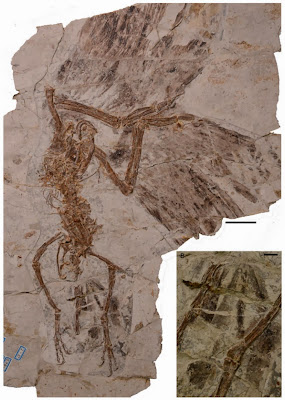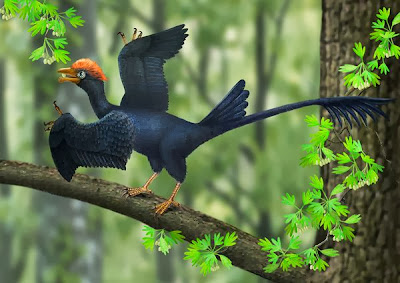Three-quarters of hand prints in ancient cave art were left by women, study finds.
Hand prints in ancient cave art most often belonged to women, overturning the dogma that the earliest artists were all men.
by Virginia Hughes
Women made most of the oldest-known cave art
paintings, suggests a new analysis of ancient handprints. Most scholars
had assumed these ancient artists were predominantly men, so the finding
overturns decades of archaeological dogma.
Archaeologist
Dean Snow
of Pennsylvania State University analyzed hand stencils found in eight
cave sites in France and Spain. By comparing the relative lengths of
certain fingers, Snow determined that three-quarters of the handprints
were female.
"There has been a male bias in the literature for a long time," said
Snow, whose research was supported by the National Geographic Society's
Committee for Research and Exploration. "People have made a lot of
unwarranted assumptions about who made these things, and why."
Archaeologists have found hundreds of hand stencils on cave
walls across the world. Because many of these early paintings also
showcase game animals—bison, reindeer, horses, woolly mammoths—many
researchers have proposed that they were made by male hunters, perhaps
to chronicle their kills or as some kind of "hunting magic" to improve
success of an upcoming hunt. The new study suggests otherwise.
"In most hunter-gatherer societies, it's men that do the killing. But
it's often the women who haul the meat back to camp, and women are as
concerned with the productivity of the hunt as the men are," Snow said.
"It wasn't just a bunch of guys out there chasing bison around."
Experts expressed a wide range of opinions about how to
interpret Snow's new data, attesting to the many mysteries still
surrounding this early art.
"Hand stencils are a truly ironic category of cave art
because they appear to be such a clear and obvious connection between us
and the people of the Paleolithic," said archaeologist
Paul Pettitt
of Durham University in England. "We think we understand them, yet the
more you dig into them you realize how superficial our understanding
is."
Sex Differences
Snow's study began more than a decade ago when he came
across the work of John Manning, a British biologist who had found that
men and women differ in the relative lengths of their fingers: Women
tend to have ring and index fingers of about the same length, whereas
men's ring fingers tend to be longer than their index fingers.
These hand stencils found in the El Castillo cave
in Cantabria, Spain, were probably made by a man (left) and a woman
(right), respectively.
One day after reading about Manning's studies, Snow pulled a
40-year-old book about cave paintings off his bookshelf. The inside
front cover of the book showed a colorful hand stencil from the famous
Pech Merle cave
in southern France. "I looked at that thing and I thought, man, if
Manning knows what he's talking about, then this is almost certainly a
female hand," Snow recalled.
Hand stencils and handprints have been found in caves in
Argentina, Africa, Borneo, and Australia. But the most famous examples
are from the 12,000- to 40,000-year-old cave paintings in southern
France and northern Spain.
For the new study, out this week in the journal American Antiquity,
Snow examined hundreds of stencils in European caves, but most were too
faint or smudged to use in the analysis. The study includes
measurements from 32 stencils, including 16 from the cave of El Castillo in Spain, 6 from the caves of Gargas in France, and 5 from Pech Merle.
Snow ran the numbers through an algorithm that he had created based
on a reference set of hands from people of European descent who lived
near his university. Using several measurements—such as the length of
the fingers, the length of the hand, the ratio of ring to index finger,
and the ratio of index finger to little finger—the algorithm could
predict whether a given handprint was male or female. Because there is a
lot of overlap between men and women, however, the algorithm wasn't
especially precise: It predicted the sex of Snow's modern sample with
about 60 percent accuracy.
Luckily for Snow, that wasn't a problem for the analysis of
the prehistoric handprints. As it turned out—much to his surprise—the
hands in the caves were much more sexually dimorphic than modern hands,
meaning that there was little overlap in the various hand measurements.
"They fall at the extreme ends, and even beyond the extreme
ends," Snow said. "Twenty thousand years ago, men were men and women
were women."
Woman, Boy, Shaman?
Snow's analysis determined that 24 of the 32 hands—75 percent—were female.
Some experts are skeptical. Several years ago, evolutionary biologist
R. Dale Guthrie
performed a similar analysis of Paleolithic handprints. His work—based
mostly on differences in the width of the palm and the thumb—found that
the vast majority of handprints came from adolescent boys.
For adults, caves would have been dangerous and
uninteresting, but young boys would have explored them for adventure,
said Guthrie, an emeritus professor at the University of Alaska,
Fairbanks. "They drew what was on their mind, which is mainly two
things: naked women and large, frightening mammals."
Other researchers are more convinced by the new data.
"I think the article is a landmark contribution," said archaeologist
Dave Whitley
of ASM Affiliates, an archaeological consulting firm in Tehachapi,
California. Despite these handprints being discussed for half a decade,
"this is the first time anyone's synthesized a good body of evidence."
Whitley rejects Guthrie's idea that this art was made for
purely practical reasons related to hunting. His view is that most of
the art was made by shamans who went into trances to try to connect with
the spirit world. "If you go into one of these caves alone, you start
to suffer from sensory deprivation very, very quickly, in 5 to 10
minutes," Whitley said. "It can spin you into an altered state of
consciousness."
The new study doesn't discount the shaman theory, Whitley added,
because in some hunter-gatherer societies shamans are female or even
transgendered.
The new work raises many more questions than it answers.
Why would women be the primary artists? Were they creating only the
handprints, or the rest of the art as well? Would the hand analysis hold
up if the artists weren't human, but Neanderthal?
The question Snow gets most often, though, is why these ancient artists, whoever they were, left handprints at all.
"I have no idea, but a pretty good hypothesis is that this is somebody saying, 'This is mine, I did this,'" he said.






















